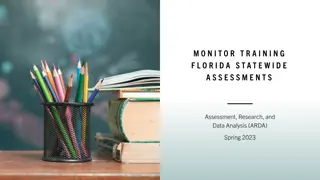Classroom Tests and Assessments: Key Steps and Purposes
Understand the importance of classroom testing and assessment in obtaining valid, reliable, and useful information on student achievement. Learn the 8 basic steps involved, different types of tests during instruction, and the significance of end-of-instruction assessments for both formative and summative purposes. Explore developing specifications for tests and assessments to ensure accurate measurement of instructional objectives.
Download Presentation

Please find below an Image/Link to download the presentation.
The content on the website is provided AS IS for your information and personal use only. It may not be sold, licensed, or shared on other websites without obtaining consent from the author. Download presentation by click this link. If you encounter any issues during the download, it is possible that the publisher has removed the file from their server.
E N D
Presentation Transcript
EDU480 PRINCIPLES OF ASSESSMENT AND EVALUATION CHAPTER 6: CLASSROOM TESTS AND ASSESSMENTS FATEN FADHLIN BT AMIR SARIPUDIN NUR ALIAH RAIHANA MOHD RAZALI NUR ATHIRAH BINTI OMAR SITI NORAIN BINTI JAHIDIN (2015429136) (2015270548) (2015 (2015635318)
Main goal of classroom testing and assessment to obtain valid, reliable, and useful information concerning student achievement.
Determine the purpose of measurement Selecting appropriate assessment tasks Developing specifications 8 BASIC STEPS OF TESTING AND ASSESSMENT Preparing relevant assessment tasks Assembling the assessment Administering the assessment Appraising the assessment Using the results
During Instruction Tests and assessments given during instruction provide the basis for formative assessment. Using a different types of test items and complex performance assessment needs to ensure that the full comprehension of objectives is assessed (meaning choose questions carefully to have understanding in the classroom.)
End-of-Instruction The main interest is in measuring the extent to which the intended learning outcomes and performance standards have been achieved. Although these end-of-instruction test and assessments are used primarily for summative assessment they can serve as other function.
Such as, 1) Feedback to students 2) Encouraging students to undertake advanced work 3) Assigning of remedial work 4) Assessing instruction as well as for grading purposes 5) Function as both formative and summative 6) Pre-test for the following unit 7) Evaluating instructional effectiveness
DEVELOPING SPECIFICATIONS FOR TESTS AND ASSESSMENTS Why developing specifications is important? Preparing a list of instructional objective It is to ensure that classroom tests and assessment measure a representative sample of instructionally relevant tasks. The device that used : Table of specifications (test blueprints) Table of specifications Outlining the course content Preparing the two-way charts
SELECTING APPROPRIATE TYPES OF ITEMS AND ASSESSMENT TASKS
THE OBJECTIVE TEST ITEM THE ESSAY TEST ITEM Highly structured and require the students to select the best answer from a number of alternatives Also known as performance assessment tasks, permit the students to organize the answer in essay form. Objective = have a single right answer or the best answer. There is not a single right/best response there may be a variety of responses that are considered excellent. For instructional purposes, objective items may be most efficient. Expert judgement is required to score the assessment. Proven to be more satisfactory to test their performance/understanding.
OBJECTIVE TEST ITEM Objective test items are divided into five (5) main components which are: 1. Multiple choice In the equation 2X+5=9, 2X means A)2 plus X B)2 multiplied by X C)2 minus X 2. Short answer What is the name of the author of Moby Dick? ______________
3. True/False or Alternative Response T F An atom is the smallest particle of matter. Yes No Acid turns litmus paper red. 4. Matching Color of the sea Color of the dirt Color of the trees - - - - - - Brown Blue Green 5. Completion In the equation 2X+5=9, X=____
To obtain the correct answer, students must demonstrate the specific knowledge, understanding, or skill. They are not free to redefine the problem or to organize and present the answer in their own words. This type of method contributes to scoring that is quick, easy, and accurate. Negative side: inappropriate for measuring the ability to formulate problems and choose an approach to solving them or the ability to select, organize, and integrate ideas.
THE ESSAY ITEM Also known as the performance assessment tasks are needed to measure student s ability to engage in hands-on activities, such as conducting an experiment, designing and conducting a survey, or writing an essay. Since essay is the most common, there are two types of essay questions: Extended-Response Restricted-Response
EXTENDED RESPONSE Permit students to decide which facts they think are most pertinent, to select their own method of organization, and write as much as seems necessary for a comprehensive answer. Tends to reveal the ability to evaluate ideas, to relate them coherently, and to express them efficiently. They are valuable for measuring complex skills and understanding of concepts and principles They have three weaknesses: Inefficient for measuring knowledge of factual material a) Scoring criteria are not as apparent to the student b) Scoring is difficult and unreliable due to the various responses, include array of factual material, organization, legibility, and conciseness. c)
Examples of extended response essay questions: Describe what you think the role of federal government should be in maintaining a stable economy in the United States. Include specific policies and programs and give reason for your proposals. 1. Explain how clouds are formed and how they affect weather and climate. 2.
RESTRICTED RESPONSE These questions minimize some of the weaknesses of extended, for three reasons: Easier to measure knowledge of factual material. Scoring are more clear to the students. Reduces the difficulty of the scoring. The negative side: less effective to measure the students ability to select, organize, and integrate ideas. In addition, if the restrictions become too tight, the questions reduce to nothing more than a objective type test.
Examples of restricted-response essay questions: State two advantages and disadvantages of maintain high tariffs on goods from other countries. Name two type of clouds and describe the characteristics that distinguish them. 1. 2.
Considerations in preparing relevant test items and assessment tasks
1.MATCHING ITEMS AND TASKS TO INTENDED OUTCOMES Each items or task need to match the intended learning outcomes as closely as possible. Spesific Learning Outcome: Identifies the function of a given body structure Relevant Test Item: What is the function of the kidney? A Eliminate waste product B Improve circulation of blood C Maintain respiration D Stimulate digestion
Prepare general item pattern as intermediate step between specific learning outcome and the test item Arranged by general type of learning outcome such as Knowledge outcomes - Understanding outcomes - Application outcomes -
2. OBTAINING A REPRESENTATIVE SAMPLE OFITEMS AND TASKS Our sampling is most likely to be representative when the preparation of a test/assessment is guided by a carefully prepared set of specification There is tendency to overload the test with items measuring knowledge of isolated facts and neglect more complex learning outcomes.
Number of Items and Tasks: -Determined when set of specification is built - Depends on purpose measurement - Type of test items - Assessment task used - Students age
3. ELIMINATING IRRELEVANT BARRIERS TO THE PERFORMANCE Possible barriers in Test Items and Assessment Tasks Ambiguous statements - Excessive wordiness - Difficult vocabulary - Complex sentence structure - Unclear instructions - Unclear illustrative material - Racial, ethnic, or gender bias -
Be certain that all students have the perquisite skills and abilities needed to make the response Avoid any racial, ethnic or gender bias in preparing the test items and performance assessment tasks. Avoid ambiguity
4. AVOIDING UNINTENDED CLUES IN OBJECTIVE TEST ITEMS Common Clues in Test Items Grammatical inconsistencies - Verbal association - Specific determiners - Phrasing of correct responses - Length of correct responses - Location of correct responses -
SELECTION TYPE ITEM: A porpoise is an A plant B Animal C Reptile D bird
SUPPLY TYPE ITEM: A piece of land that is completely surrounded by water is known as an _________ Plausible answers: Island, Peninsula
Simple verbal association Which of the following instruments is used to determine the direction of the wind? A Anemometer B Barometer C Hygrometer D Wind vane
5. GENERAL SUGGESTIONS FOR WRITING TEST ITEMS AND ASSESSMENT TASKS Use your test and assessment specification as a guide Write more items and tasks than needed Write the items and tasks than needed Write the items and tasks well in advance of the testing date Write each test item and assessment task so that the task to be performed is clearly defined and it calls forth the performance described in the intended learning outcome Write each item or task at an appropriate reading level Write each item or task so that it does not provide help in responding to other items or tasks
6. FOCUSING ON IMPROVING LEARNING AND INSTRUCTION Test and assessment can have a desirable influence on student learning if attention is paid to the breadth and depth of content and learning outcomes measured Constructing tests and assessments that measure a variety of learning outcomes should also lead to improved teaching procedures and thus indirectly to improved student learning Tests and assessments will contribute to improved teacher-student relations if the students view the tests and assessments as fair and useful measures of their achievement
Summary Planning the classroom tests and assessments involves: Determining the purpose of measurement a) Developing a set of specifications b) Selecting appropriate type of tests items and assessment tasks c) Preparing a set of relevant items or tasks d)
Classroom tests and assessments carry a variety of instructional purposes: 1. Pretests (at the beginning of a course or unit) : To determine learning readiness To aid in instructional planning To make advanced placements
2. Tests and assessments (during instruction) : To improve and direct student learning To identify and remedy learning errors
3. End-of-instruction tests and assessments (at the end of a course or unit) : To assign grades Certify accomplishment Evaluate teaching
Specification Makes a sample of student performance more likely to be representative Define and delimit the achievement domain to be measured Describe the sample of test items and assessment tasks
Table of Specification (TOS) (A two way chart) Building the table involves: Obtaining the list of instructional objectives o Outlining the course content o Preparing the TOS which relates the instructional objectives to the course o content
Preparing a set of relevant test items and assessment tasks involves: Matching the items and tasks to the learning outcomes as directly as a) possible Obtaining a representative sample of all intended outcomes b) Eliminating irrelevant barriers to the answer c) Preventing unintended clues to the response d) Focusing on improving learning and instruction e)























